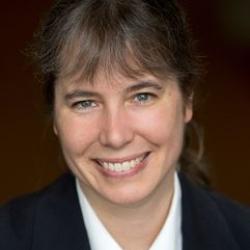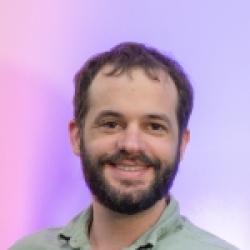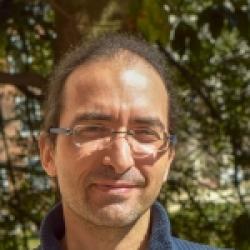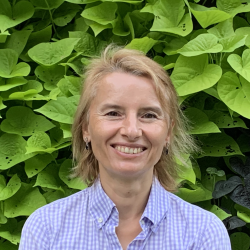
Graph Convolutional Neural Networks: The Mystery of Generalization
2:00 PM
Online via Zoom
Prof. Gitta Kutyniok, Mathematical Institute of the University of Munich
The tremendous importance of graph structured data due to
recommender systems or social networks led to the introduction of
graph convolutional neural networks (GCN). Those split into spatial
and spectral GCNs, where in the later case filters are defined as
elementwise multiplication in the frequency domain of a graph.
Since often the dataset consists of signals defined on many
different graphs, the trained network should generalize to signals
on graphs unseen in the training set. One instance of this problem
is the transferability of a GCN, which refers to the condition that
a single filter or the entire network have similar repercussions on
both graphs, if two graphs describe the same phenomenon. However, for a long time it was believed that spectral filters are not transferable.
In this talk we aim at debunking this common misconception by
showing that if two graphs discretize the same continuous metric
space, then a spectral filter or GCN has approximately the same
repercussion on both graphs. Our analysis also accounts for large
graph perturbations as well as allows graphs to have completely
different dimensions and topologies, only requiring that both
graphs discretize the same underlying continuous space. Numerical
results then even imply that spectral GCNs are superior to spatial
GCNs if the dataset consists of signals defined on many different
graphs.
This is joint work with R. Levie, W. Huang, L. Bucci, and M.
Bronstein.
Consensus-Based Optimization Over the Sphere: Theoretical Guarantees and Applications in Machine Learning
2:00 PM
Online via Zoom
Prof. Massimo Fornasier, Department of Mathematics, Technical University of Munich
We introduce a new stochastic Kuramoto-Vicsek type model for global optimization of nonconvex functions on the sphere. This model belongs to the class of Consensus-Based Optimization methods. In fact, particles move on the sphere driven by a drift towards an instantaneous consensus point, computed as a convex combination of the particle locations weighted by the cost function according to Laplace's principle, which represents an approximation to a global minimizer. The dynamics is further perturbed by a random vector field to favor exploration, whose variance is function of the distance of the particles with respect to the consensus point. In particular, as soon as consensus is reached the stochastic component vanishes. In the first part of the talk, we study the well-posedness of the model and we derive rigorously its mean-field approximation for large particle limit. The main results of the second part of the talk are about the proof of convergence of the numerical scheme to global minimizers provided conditions of well-preparation of the initial datum. The proof combines the previous results of mean-field limit with a novel asymptotic analysis, and classical convergence results
of numerical methods for SDE. We present several numerical experiments, which show that the algorithm scales well with the dimension and is extremely versatile. To quantify the performances of the new approach, we show that the algorithm is able to perform essentially as good as ad hoc state of the art methods and in some instances it obtains quantifiable better results in challenging problems in signal processing and machine learning, namely the phase retrieval problem and the robust subspace detection.
Deep Analog-to-Digital Compression: Tasks, Structures, and Models
2:00 PM
Online via Zoom
Prof. Yonina Eldar, Electrical Engineering, Weizmann Institute of Science
The famous Shannon-Nyquist theorem has become a landmark in the development of digital signal and image processing. However, in many modern applications, the signal bandwidths have increased tremendously, while the acquisition capabilities have not scaled sufficiently fast. Consequently, conversion to digital has become a serious bottleneck. Furthermore, the resulting digital data requires storage, communication and processing at very high rates which is computationally expensive and requires large amounts of power. In the context of medical imaging sampling at high rates often translates to high radiation dosages, increased scanning times, bulky medical devices, and limited resolution.
In this talk, we present a framework for sampling and processing a large class of wideband analog signals at rates far below Nyquist in space, time and frequency, which allows to dramatically reduce the number of antennas, sampling rates and band occupancy.
Our framework relies on exploiting signal structure and the processing task. We consider applications of these concepts to a variety of problems in communications, radar and ultrasound imaging and show several demos of real-time sub-Nyquist prototypes including a wireless ultrasound probe, sub-Nyquist MIMO radar, super-resolution in microscopy and ultrasound, cognitive radio, and joint radar and communication systems. We then discuss how the ideas of exploiting the task, structure and model can be used to develop interpretable model-based deep learning methods that can adapt to existing structure and are trained from small amounts of data. These networks achieve a more favorable trade-off between increase in parameters and data and improvement in performance, while remaining interpretable.
A regularity method for lower bounds on the Lyapunov exponent for stochastic differential equations
2:00 PM
Online via Zoom
Prof. Jacob Bedrossian, Department of Mathematics, University of Maryland
Chaos is commonly observed in a wide variety of high dimensional systems in physics, however, there are few mathematical tools for obtaining positivity or quantitative estimates on Lyapunov exponents for the vast majority of physical systems. In a recent joint work with Alex Blumenthal and Sam Punshon-Smith, we put forward a new method for obtaining quantitative lower bounds on the top Lyapunov exponent of stochastic differential equations (SDEs) based on the Fisher information of a particular auxiliary Markov process. As an initial application, we prove the positivity of the top Lyapunov exponent for a class of weakly-dissipative, weakly forced SDE and that this class includes the Lorenz 96 model, originally introduced as a toy model for atmospheric dynamics, with any number of unknowns greater than or equal to 7 (the original model has 40). This is the first mathematically rigorous proof of chaos (in the sense of positive Lyapunov exponents) for Lorenz 96, despite the overwhelming numerical evidence of chaos. If time permits, I will also discuss application of the method also to more complicated models such as the finite dimensional truncations of the classical shell models of hydrodynamic turbulence, GOY and SABRA.
Probing Electron Transport with Light: A Flavor of Edge States in 2D Materials
2:00 PM
Online via Zoom
Prof. Dionisios Margetis, Department of Mathematics, University of Maryland
Recent studies in the properties of atomically thin materials have offered valuable insights into aspects of 2D electron transport. In many nanophotonics applications, 2D materials such as doped graphene behave as Ohmic conductors and allow for the excitation of fine-scale electromagnetic waves. These surface waves are tightly confined to the 2D material and can beat the optical diffraction limit. In another kinetic regime of interest, 2D electron systems exhibit a behavior similar to that of classical fluids. These findings point to the need for predictions that may guide future experiments. A goal is to understand how distinct kinetic regimes of 2D electron systems can be reasonably probed by electromagnetic signals.
In this talk, I will discuss recent theoretical progress in describing the existence of edge modes in flat anisotropic conducting sheets. Some emphasis will be placed on an emergent topological concept for such modes. If time permits, I will also discuss recent results on the excitation of bulk modes by antennas over viscous 2D electron systems.
Modeling fracture in hydrogels
2:00 PM
Online via Zoom
Prof. Maria Cameron, Department of Mathematics, University of Maryland
Modeling and analysis of fracture in various materials has been a problem of great practical importance. Typically, breaking strength and work of fracture of a real material sample is reduced by orders of magnitude by imperfections present in it. Micro-level physics of fracture for some materials such as glass is well-understood, while for others like hydrogel needs yet to be explained. The goal of this work is to design and investigate a model that sheds light on physics of breaking hydrogel. We propose a 2D network model featuring a nonlinear stress-strain relationship and a scatter in equilibrium link lengths. We investigate this model by means of numerical simulations and demonstrate a dramatic reduction in breaking strength compared to that of the corresponding perfect network.






